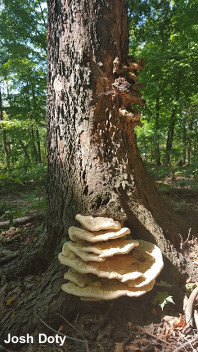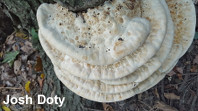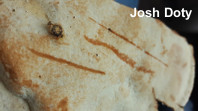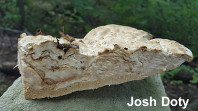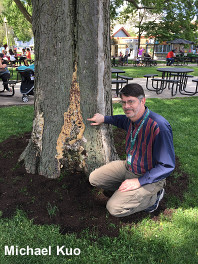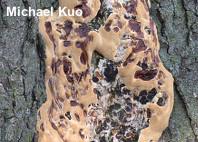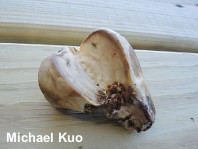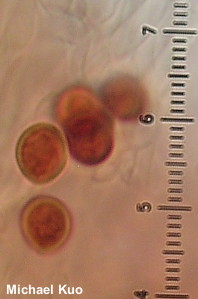| Major Groups > Polypores > Perenniporia robiniophila |

|
Perenniporia robiniophila [ Basidiomycota > Polyporales > Polyporaceae > Perenniporia . . . ] by Michael Kuo This large but nondescript polypore appears to be fairly common in the Midwest and the Mid-Atlantic states, below the Great Lakes. It is usually found on the wood of hackberry or black locust, growing above ground, near (but not at) the base of the tree. Its surfaces are white, but they turn brown when bruised. According to Overholts (1953), Perenniporia robiniophila is common on black locust "[i]n the Ohio River Valley . . . but it seems to be better developed when growing on hackberry than on any other host." At first glance Bondarzewia berkeleyi looks very similar (at least, when Perenniporia robiniophila makes shelving caps rather than a simple mass of pore surfaces)—but Bondarzewia berkeleyi develops a large stem-like structure, does not bruise brown, is usually found on oaks as a butt rot at the very base of the tree, and has spores that look very different under the microscope. Trametes robiniophila and Polyporus robiniophilus are former names. Thanks to Josh Doty for collecting, documenting, and preserving Perenniporia robiniophila for study; his collection is deposited in The Herbarium of Michael Kuo. And thanks to Patrick Leacock of the Field Museum in Chicago for pointing me toward a collection growing right outside the museum. Description: Ecology: Parasitic and saprobic on the living and dead wood of hardwoods—especially hackberry and black locust; often appearing low on the tree, near the ground; causing a white to pale brownish heart rot; annual; growing in shelving clusters, or as a resupinate mass; appearing year-round; apparently widely distributed in North America east of the Rocky Mountains. The illustrated and described collections are from Illinois and Pennsylvania. Fruiting Body: A mass of shelving caps or, sometimes, of cap-less pore surfaces; up to 60 cm high and 30 cm across. Caps: 5–40 cm across and up to 25 cm deep; semicircular to fan-shaped in outline; planoconvex to flat; lumpy; white; bruising brownish; developing brownish spots and areas toward the point of attachment; the margin thick, rounded, and white. Pore Surface: White; bruising brownish to brown, and eventually developing glossy brown blisters; with 3–6 circular pores per mm; tube layer to 10 mm thick. Stem: Absent. Flesh: Zoned; with whitish, watery, and brownish zones; staining brownish when sliced; leathery to corky. Odor: Not distinctive. Chemical Reactions: KOH negative on cap, flesh, and pore surface. Spore Print: Undocumented. Microscopic Features: Spores 6–8 x 6–7 µm; subglobose to broadly ellipsoid; smooth; walls about 1 µm thick; hyaline in KOH; dextrinoid. True cystidia absent. Hyphal system dimitic: generative hyphae thin-walled, clamped; skeletal hyphae very thick-walled, aseptate, dextrinoid. REFERENCES: (Murrill, 1907) Ryvarden, 1983. (Saccardo, 1912; Overholts, 1953; Gilbertson & Ryvarden, 1987.) Herb. Kuo 09111501, 06061601. This website contains no information about the edibility or toxicity of mushrooms. |
© MushroomExpert.Com |
|
Cite this page as: Kuo, M. (2016, August). Perenniporia robiniophila. Retrieved from the MushroomExpert.Com Web site: http://www.mushroomexpert.com/perenniporia_robiniophila.html |
